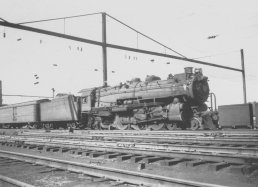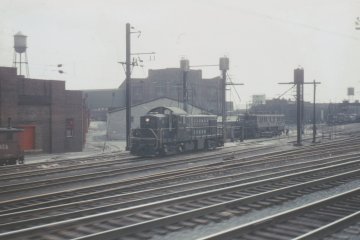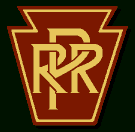
|

|

|

color photo courtesy of George Pitz (Thanks, George!!) BR>
Before its demise, the Orangeville locomotive facility was THE hub for the Pennsylvanuia railroad activity in Baltimore. The two previous photo pages, (1 and 2 ) show Orangeville in its days after CONRAIL abandoned it and the page titled "Mike's Pennsylvania RR stuff - The building of Orangeville - 1911" , which follows the construction of Orangeville as described in a railway ongineering magazine of the time.
Sadly, none of these pages could discuss the period between those times becuase, frankly, I
didn't have the information at my disposal. However, the gracious intercssion of the
Baltimore Chapter, National Railway Historical Society
has changed that, and, with my greatest apprciation, they have made the following photographs
available to me. Credits are given on each phorograph and as much information as I can
glean accompanies each pircture.
Here is Orangeville!
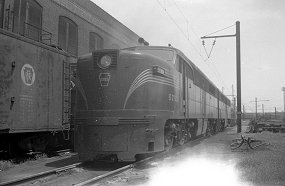 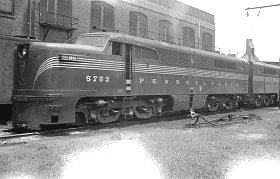 Another view of 5753 alongside the shop building. In this shot the antennae for the Trainphone™ system are clearly visible. Note the coaling tower sticking up above the "B" unit. Photo courtesy of and © The Baltimore Chapter, National Railway Historical society |
†TheTrainphone™ system was pioneered by the Pennsylvania Rialroad in conjunction with Union Switch and Signal. The goal was essentially to provude a safe radio system for train crews. Other types of radio in use at the time were space radio, which used open airwaves to send and receive signals, like modern AM or FM radio, and the rail carrier system, where a current was generated by a transmitter, sent through the rails and picked by receiver coils. Each of these sytems had their own inherent problems, however. The space radio system had two problems: the allocatio of high-frequency channels; and the security for,and inteference to, the signals. The rail carrrier system also had two problem to overcome: the signal tended to fade over long distances, and, since it the used the rails to transmit the current, if there was any damage to the rails, the frequency was interrupted.
The Trainphone™ system alleviated all of these problems, because it combined elements of the
rail carrier system and the space radio system. The carrier current was fed indutively
through the rails by a transmitting loop. The ground provided the return path for the resultant
rail current, which, in turn, inductively energized the adjacent line wires . the current
in the wires set up a magnetic field, which in turn induced a current in the rails which was
picked up by the receiving coils. Transmission through the rails alone tended to diminish,
as with the rail carrier system, but the current in the wayside wires acted as a booster.
| Orangeville pics, page 1 | |
| Orangeville pics, page 2 | |
| Camden Yards page | |
| Mike's Railroad Home Page |
 |
even if you tie, you lose |
 |
Last updated Friday, February 8, 2012
NO PHOTOGRAPHS MAY BE USED, BORROWED OR REPRODUCEDWITHOUT THE EXPRESS PERMISSION OF THE BALTIMORE CHAPTER, NATIONAL RAILWAY HISTORICAL SOCIETY
